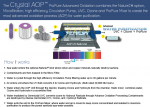I noticed. Maybe more details would help.
I Have an H2X trainer Swim Spa
2,500 Gallons
It has the Mast3rPur™ Water Management System [AOP] below is a quick overview pic and below a nice article that really goes deep into what it is.
I started with super clear municipal water and the pool was doing fine for the first few days. than it started getting kinda cloudy. i had already added the leisure renew, so i read about bromine and went out and purchase the sodium and established a bank. What i have noticed from reading lots of articles is that chlorine is what is used as a supplement with this type of system not bromine. So my thoughts are to drain the spa and start again. Should i treat it as a regular pool and get my chlorine and ph leveled or should i be treating this a bit different from the start? if i do go the chlorine route i see some of you are using just regular bleach. should i use bleach or stick with chlorine tablets?
The Big 3 of Sanitation Explained: Ozone, UV and AOP
An expert provides a deeper look into how the three water-sanitation processes work separately and together
By
Beth Hamil
There is still some confusion surrounding the science behind ozone and UV systems, even though these two water sanitation processes have been available for a while. When the two are combined to form the newest innovation – Advanced Oxidation Process (AOP) -- there can be even more confusion. AOP has been around for more than 30 years in the wastewater-treatment world, but has only recently become an affordable option for aquatics facilities and residential pools. In order to fully grasp AOP, one must first understand the nature of ozone and UV – as well as their performance.
What is Ozone?
Ozone (O3) is a gas that can be created inside a chamber by passing oxygen through either a light energy field (called UV ozone) or an electrical energy field (called CD ozone). The ozone generator uses either light or electrical energy as well as oxygen from the surrounding air. Regular oxygen molecules (O2) get split into two individual atoms (O1) when this kind of energy is added. The O1 atoms then unite with other oxygen molecules (O2), which produces O3. The only difference between ozone generated by light energy vs. electrical energy is the quantity -- electrical generation produces higher ozone output.
When dissolved in water, ozone will kill pathogens and microorganisms, destroy organics and inorganics, and also will break down chloramines through oxidation. The oxidation reaction happens when an ozone molecule collides with an oxidizable substance, such as algae, bacteria, sweat, urine, mold spores, and protozoa, which then causes the weakly bonded third oxygen atom to split off. During this reaction, organic molecules are destroyed, and dissolved metals become insoluble. The leftover byproduct is O2, which capably reduces chlorine consumption by 50-75 percent.
DEL Ozone
Ozone is a significantly stronger oxidizer than chlorine, and is able to kill chlorine-resistant
cryptosporidium parvum. It’s an antimicrobial oxidizer that is a sanitizer and a disinfectant, which is highly effective in removing biofilm. Ozone also is an impressive microflocculant. It clumps organic and inorganic contaminants together during the oxidation process so they’re more easily removed by the filter.
What is Germicidal UV?
DEL Ozone
Germicidal UV systems (also known as Ultraviolet Sterilizers) pass water through a chamber and expose it to light, which kills microorganisms and breaks down chloramines using light energy. In order to sanitize water, specific UV light rays must be used – 254 nm has the greatest germicidal action. The germicidal light alters or disrupts the DNA or RNA of microorganisms such as algae, bacteria, viruses, mold spores, and protozoa. This essentially destroys the microorganisms as they pass through the UV chamber.
A UV lamp produces UV light in a chamber that is powered by electricity. It effectively inactivates harmful microorganisms, including
cryptosporidium parvum. The process leaves no harmful byproducts and is able to reduce chlorine consumption by 25-50 percent.
How are they different?
The two forms of water sanitation are easily confused. Both ozone and UV are EPA-approved water sanitizing devices. They’re also compatible with chlorine, able to reduce chloramines, and are environmentally friendly technologies. However, ozone is able to provide oxidation and UV is not, which is a very important characteristic of ozone.
Germicidal UV uses light rays alone to disrupt DNA or RNA of microorganisms. Ozone is a gas that can effectively be created using light or electrical energy. It may then be safely dissolved in water in order to destroy microorganisms and break down chloramines through oxidation.
What is Advanced Oxidation Process or AOP?
This is where ozone and UV come together. There are many forms of AOP, but the most common one – and the one available in the pool and spa industry – is made through a combination of CD ozone and UV. Combining ozone and UV technology into one cohesive system creates synergistic sanitation, which maximizes disinfection, water clarity, and chloramine removal.
In an AOP system, ozone gas is dissolved in water and then passes through a chamber with a germicidal ultraviolet lamp. When UV energy is combined with ozone, it creates a chemical reaction resulting in hydroxyl radicals - short-lived, but very powerful oxidizers that can kill pathogens and microorganisms, as well as destroy inorganic contaminants in the water. They’re even stronger oxidizers than ozone alone.
DEL Ozone
In order to have AOP, both ozone and UV are needed. As water flows through the system, hydroxyl radicals are being formed continuously. This cannot occur without ozone. The more ozone molecules in the system, the more hydroxyl radicals are created.
After the hydroxyl radicals oxidize contaminants in the water, they quickly convert back to oxygen. This makes AOP a safe, sustainable, and green technology. It also provides the cleanest pool water with the lowest amount of chlorine needed.






